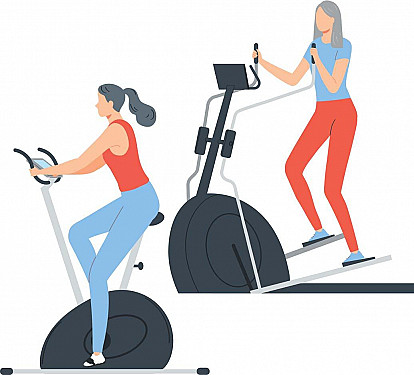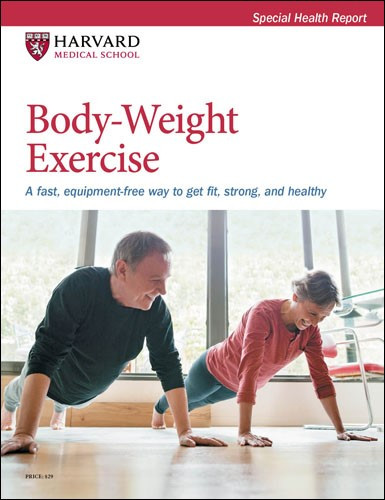One chair, four moves
This routine can fill in for or supplement your usual workout.
- Reviewed by Howard E. LeWine, MD, Chief Medical Editor, Harvard Health Publishing; Editorial Advisory Board Member, Harvard Health Publishing

The CDC estimates Americans spend up to eight hours per day sitting, but ironically, the instrument of our sedentary time is also a versatile piece of exercise equipment: the chair.
"Using a chair to exercise is a great way to supplement your regular workout, or as a replacement when you can't do your usual routine," says Dr. Sarah Eby, assistant professor of physical medicine and rehabilitation at Harvard-affiliated Spaulding Rehabilitation Hospital. "It also can be used for people returning to exercise after an injury or surgery or for those with physical limitations."
Chair exercises also can address two areas people need help with as they get older: strength and flexibility. "Both become increasingly important as we age, as they help keep us active and protect against falls and injury," says Dr. Eby.
You can do almost any strength and flexibility exercise using a chair, and modify them to make the movements more or less challenging. Here is a four-exercise routine that addresses the major muscle groups. "If you have any issues with certain movements, or if you are recovering from an injury or surgery, check first with your doctor or personal trainer," says Dr. Eby.
Chair push-up (arms, shoulders, chest, back)
Place the back of the chair against a wall. Place your hands shoulder-width apart on the chair's seat. Walk your feet back so your body is at a 45° angle to the floor and forms a straight line from head to heels. Your heels should be off the floor. Bend your elbows out to the sides and slowly lower your upper body toward the chair until your elbows are bent about 90°. Hold for one to two seconds. Press against the chair seat and straighten your arms to return to the starting position. Do eight to 12 times. Rest and repeat the sequence two times.
- Make it easier: Do the push-up on your knees, with hands on the front of the seat.
- Make it harder: Take three to five seconds to lower and raise your body.
Chair stand (abdomen, hips, front thighs, and buttocks)
Sit upright at the front of the chair, knees bent, feet flat on the floor and slightly apart. Cross your arms and place your hands on your shoulders. Keeping your back and shoulders straight, stand slowly, pause, and then slowly sit. Do eight to 12 times. Rest and repeat the sequence one or two times.
- Make it easier: Use your hands to help you stand.
- Make it harder: Rise from the chair quickly and take five seconds to sit.
Hip extension (buttocks and back thighs)
Place the front of the chair against a wall. Stand 12 inches behind it. Holding on to the back of the chair for balance, bend your trunk forward 45°. Slowly raise your right leg straight out behind you. Lift it as high as possible without bending your knee. Pause at the top and then slowly lower the leg. Do this eight to 12 times. Repeat with your left leg. Do the sequence twice.
- Make it easier: Slightly bend the knee of the raised leg.
- Make it harder: Lift your leg quickly, hold briefly, and lower at a slower pace. Or wear ankle weights.
Body stretches (core, back)
This routine involves three stretches: side bend, twists, and forward lean. Repeat the sequence two to three times.
Side bend: Sit straight with your arms extended upward, and clasp your hands, palms in. Bend from the hip to the right as far as possible without pain or discomfort. Hold for five to 10 seconds. Bend to the left and hold for five to 10 seconds.
- Make it easier: Raise only one arm at a time (right arm for bending to the left and vice versa).
- Make it harder: Hold the stretch longer on each side.
Twist: Sit up straight, arms crossed over your chest or placed down alongside your body. Rotate your shoulders as far in one direction as possible without discomfort. Hold for five to 10 seconds, then return to the starting position. Repeat to the other side.
- Make it easier: Use the chair arms or back of the chair to help you twist.
- Make it harder: Hold the stretch longer or twist farther.
Forward lean: Sit with one leg extended forward and the other knee bent 90°. Lean toward the extended leg, resting one hand on each thigh for support. Continue hinging forward at the waist until you feel a stretch in the back of the straight leg. Hold for five to 10 seconds; then return to the starting position. Switch leg positions and repeat.
- Make it easier: Wrap a towel or strap around the foot of the extended leg and pull the ends to help you fold into the stretch.
- Make it harder: Hold the stretch for a longer time.
Image: © Koldunov/Getty Images
About the Author

Matthew Solan, Executive Editor, Harvard Men's Health Watch
About the Reviewer

Howard E. LeWine, MD, Chief Medical Editor, Harvard Health Publishing; Editorial Advisory Board Member, Harvard Health Publishing
Disclaimer:
As a service to our readers, Harvard Health Publishing provides access to our library of archived content. Please note the date of last review or update on all articles.
No content on this site, regardless of date, should ever be used as a substitute for direct medical advice from your doctor or other qualified clinician.
















